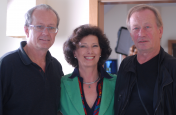Director, scriptwriter and producer
Born 14th of August 1945 in Sv. Jakub (nowadays a part of Banská Bystrica).
He was a pedagogue of directing at the Academy of music and dramatic arts in Bratislava, a member of the Federal board for broadcasting and retransmission of the Czechoslovak federative republic, a member of the Board of Slovak Television, vice-president of the Slovak Film and Television Academy.
He is a member of the Audiovisual fund board as well as a member of the Film institute board.
He lives in Bratislava with his wife Deana (www.dealutherova.sk). He has two daughters, Silvia and Soňa. He is the brother of the cinematographer Igor Luther and ethnologist Daniel Luther.
Even a very simple or precursory portrait of the Slovak director and scriptwriter Miloslav Luther would be inevitably distorted, had his first professional contacts with the world of film not been mentioned. Before he started attending the legendary Film academy of performing arts in Prague (FAMU), he was an assistant of Stanislav Barabáš during his shooting of the TV film Krotká (1967) as well as Ivan Balaďa also during the shooting of the TV film Dáma (1967). He was also working as a graphic artist for Diapolyekran, which had then represented the former Czechoslovakia at the Expo in Montreal, Canada. In 1968, when cooperating on the debut of Elo Havetta Celebration in the Botanical Garden (1969), he was admitted to FAMU. He started his studies in a period of the ending short liberalization and finished it in a time, when culture and cinematography in particular was decimated by the brutal normalization. Some artists emigrated, one of them being Luther’s brother Igor (who was already at the time of his emigration a reputable and sought-after cinematographer), many of those who stayed were affected by various restrictions or were even prohibited to work.
After finishing his studies at FAMU, Miloslav Luther began to work as a director in Bratislava’s newsreel and later in the Czechoslovak television. He has shot documentary portraits of artists - Mikuláš Galanda (1977) Oles Hončar (1977), Anton Krajčovič (1977), National artist Emil Belluš (1979). He has also created numerous great films and TV dramas. As pars pro toto, the TV drama Mario and the magician (1976), an adaptation of the eponymous novel by Thomas Mann, has to be mentioned. Why this work in particular? Primarily because in 1977 it was awarded at the ITF Monte Carlo with a Silver nymph – the main prize in the dramatic programs category, as well as the Cino del Duca prize for the best work created by a director up to 35 years of age. These two awards count to the most important within Luther’s professional career, although paradoxically, he could not pick up his award personally, because the normalisers did not let him travel to Monte Carlo. Another reason is that this work of art comprises in a condensed way everything that is distinctive for the directing style of Miloslav Luther to this day.
Firstly it is the liking in adaptations – during his long career he has adapted a number of works form Slovak, Czech, but also international literature. These were for example works by Alfonz Bednár, Ladislav Nádaši-Jégé, František Švantner, Jozef Gregor Tajovský, Vladimír Körner, Vladislav Vančura, Pavel Kohout, Thomas Mann, Miroslav Krleža, Choderlos de Laclos and Alfred de Musset. Secondly, Luther was and still is fascinated by literary works, the narratives of which are tightly bound to a certain historical context. It is not to be said that he creates classic historical films, but undoubtedly he creates works that use historical realia, thereby multiplying the suggestion and authenticity of the filmic statement. Thirdly, Mario and the magician thematizes man struggling with power that wants to subdue him and manipulate him.
The interest in stories, which deal with man trying to resist or avoid the pressures of power, to extricate from the reach of power or simply to befool it, is a theme that Luther is interested in for more than thirty years. You could say that power games are in the centre of his attention: though not only political games, where the individual always gets the shorter end and that tend to end tragically; but more about the games between man and woman, older and younger generation as well as games that various groups play. Also, these games can collide with each other, support, collide or antagonize each other. Fourthly, Luther does not present these games as a purpose per se, but functionally, meaning that particular games are a means of revealing the ways of thinking, acting and feeling of people in common as well as extreme situations, so that the viewer could imagine what Jan Jessenius felt during the unsettling times of the Rudolfian era, Wolfgang Amadeus Mozart in the Habsburg monarchy, Kryštof and Anežka during the First World War, Jana Myslbeková and Tomáš Barány during the interwar Czechoslovak republic, , Viktor and Francek during the protectorate and the fascist Slovak state, or Karol and Rudo after the fall of communism in the Czech and Slovak republics. Luther’s artistic intention is to create film fictions, which can be perceived by the viewer as reality itself.
The aforementioned power games are not an invention of our time, they were here from the beginning of history and they will probably stay for a long time. The only aspect that differentiates them is the form (always significant for the various eras), which is reflected in Luther’s films as a symbiosis of the universal and the historical. Some examples of filmic examinations of the acting of a man caught in power games are the films Forget Mozart (1985), Bit part (1988), A path across Danube (1989), Witness of the Dying Time (1990), Try to embrace me (1991), the games between men and women are presented in the films Angel of Mercy (1993), or even the fairytale King Blackbird (1984), the games between men and women and simultaneously between the older and younger generation are represented by the films Escape to Buda (2002) and Mosquitoes‘ Tango (2009).
To make this portrait complete, it needs to be said that Luther, as a director and scriptwriter, has created an artwork, which is thematically heterogenous, but stylistically homogenous. Without needless hypertrophy, Luther counts as one of the few Slovak directors that have a style of their own. In the end, this style points to original filmic thinking, which is the most precious thing an artist can have. Miloslav Luther knows this very well, and therefore he cultivates his style – the proof for this are films that delight and surprise.
Prof. PhDr. Peter Michalovič, PhD.
..


